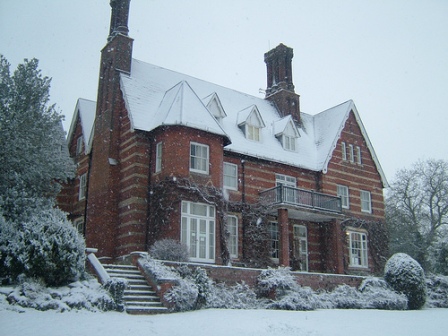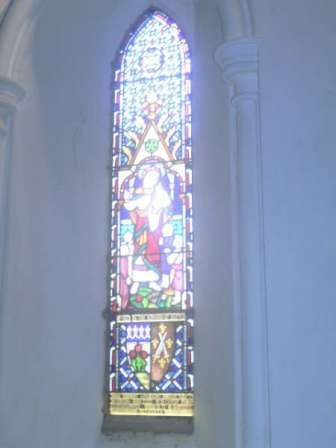 |
Wicken Bonhunt The History of Wicken House |
 |
| Wicken Bonhunt homepage |
The History of Wicken House
By Deborah Lowe
Wicken House in winter
The first Rectory was located north of the church and burnt down in 1590.2Its replacement was smaller, built from timber and had a walled kitchen garden. Census records for 1841, before Wicken House was built, show that curate Charles George of Enfield in Middlesex lived at Rectory Farm with his five daughters, one son and two female servants. Ten years later the 1851 census describes Charles George as a widower aged 66 whose occupation is ‘Rector of Wicken’. The family home is not named but shows the occupants of the household on census night. Charles’ son William aged 39 also a widower gives his occupation as ‘master mariner’ along with one daughter and two female servants.
The present building was constructed by Reverend John Hanson Sperling, BA. He and his family lived at Rectory House (as it was then known) for six years and received the living at St Margaret’s church under the patronage of his father John Sperling of Kensington Palace Gardens, Knightsbridge. John Hanson Sperling was also the architect designing every detail of the plan himself. He published an article about his design for the church magazine The Ecclesiologist. John had followed in his father’s footsteps. After finishing his education at Trinity College Cambridge, he became Rector of Westbourne in Surrey, a church that was linked to Stansted via its patron the Earl of Halifax.
With little information about his personal life, it is not possible to assess Sperling’s character however he was a controversial figure. At the age of 26 the young Rector was criticised for airing ‘high church views’ in the Westbourne Magazine which he founded in 1864.3 Writing would play an important role in his career with publications on church walks and church hymnals.4 Most controversial were the written articles about church organs. John Hanson Sperling was posthumously ‘well known in organological circles’ for his ‘tractarian format and fervour’.5
When John and his family settled in Wicken, the first priority was building a new Rectory. The ground floor comprised elegant family living rooms with 10’ ceilings and marble fire surrounds. The house had ten bedrooms; the first floor contained the family bedrooms while the attic provided small bedrooms for servants. One special feature was a family chapel built near the entrance hall which was fitted with stalls and a stained glass window. Although the room was small the height was immense going all the way up into the roof. Overall the house epitomised Victorian values of solidity and upper middle class country living.
The entry in the 1861 Census is particularly interesting because it records both ‘The Old Rectory’, now home to William Wisbey, gardener and domestic servant and the new ‘Rectory House’, home to 36 year old John Hanson Sperling and his young wife Annie. They had two children: Alfred aged 4 and baby Annie aged 1. The village schoolmistress Frances Howell lived with the Sperlings and was employed as a ‘domestic’. The family had lots of help as they also kept a cook, a nurse and a nursemaid. The adjoining land which totalled 35 acres is named ‘Church Farm’ and was occupied by James Brooks aged 59.
Major changes at St Margaret’s church were undertaken in 1858–9 when both interior and exterior were altered to what we see today. The 13th century chancel was restored and new stalls providing 200 sittings and stained glass windows were added inside. The greatest change however was to the exterior where a Nave, South Porch and West tower were added.
St Margaret’s contains a touching memorial left by the Sperling family. On the south side of the chancel a stained glass window shows the figure of Christ holding a young child and surrounded by children. The inscription reads ‘Of such is the kingdom of heaven’ and in Latin ‘Born July 29th 1855, christened August 29th 1855, died March 11th 1856’, in dedication to John Barrow Sperling the vicar’s infant son.
The following rector was the Reverend William Bowers Bliss MA, who remained at Wicken until his death in 1915. His patron was Mr Henry Bliss QC, whose relatives placed a memorial in the nave of the church following his death in 1873. There was another Bliss memorial in the garden of Wicken House placed there in memory of William’s dog Punch who was buried and commemorated with a headstone reading ‘In memory of Punch, faithful and true 1880’.
William Bliss had a long history with the village and saw many changes in rural life. One of the developments of the early years of the 20th century was air travel. In the village, confidence in this new idea was damaged in 1903 when the airship Beta crashed in the fields behind the house. The idea of air travel grew and political motives saw the increased demand for airfields close by which would greatly affect the number of aeroplanes flying overhead.
Following the death of William Bliss in 1915, the living was combined with Arkesden. The new rector, the Reverend Samuel Rowton DD lived in Arkesden, as did his successor the Reverend J. P. Whitney DD who stayed only a few months. He was succeeded by the Reverend James H. Gordon Smith MA. Mr Smith, who was blind, lived in Arkesden although his sister Mrs Boon lived in one of the rectory cottages in the village. Redundant as a rectory, Wicken House stood empty for four years. Then the church relinquished the house under the stewardship of Reverend Smith.
Wicken House was sold at auction in London in October 1919. It was sold as two lots by Hampton and Sons. The sale catalogue describes the residence as impressive with central heating by hot water pipes to many of the rooms. The first floor is described as having large bedrooms with 10’ceilings which were mostly south facing. The particulars of sale also point out that although there were no bathrooms, this could easily be converted.
The house was serviced by a scullery with hot and cold water, larder, laundry, fruit and wood stores plus wine and coal cellars. The outside offered pleasure grounds, a thatched summer-house, a peach house, two heated vineries, a mushroom house, a fowl house and a range of forcing pits. There was also a tennis court, winding shrubbery walks and a fine lawn. The familiar exterior was already by 1919 ‘partially clad in creeper and wisteria’.
The house and its grounds, pasture and arable land totalled about 44 acres. The two lots were sold to Ronald Cory-Wright who paid £3,350: £2,500 for the house and grounds and £850 for the remaining pasture and arable land. As a former church property, Wicken House had no title deeds. However the Statutory Declaration Act of 1835 enabled a statement to be made in place of the deeds. The statement was made in 1920 by the Reverend Herbert Mathew Fearn vicar of Arkesden who declared ‘by personal knowledge that the property had been possessed during the previous forty years by the rector and his predecessors’.
With the sale complete the Cory-Wrights moved in and had many happy occasions at the house. The purchase money had been funded by a mortgage of £5,000 borrowed from a relative, Sir Arthur Cory Cory-Wright. The 1920s and 30s however were times of economic difficulty and the depression. On December 15th 1930 the Cory-Wrights gave up ownership of the property and Sir Arthur received £3,135 in settlement of the original loan. Mrs Jackson, a widow of Kensington Palace Mansions, became the new owner. She moved in along with her daughters but quickly began to sell off land.
In 1931 Mrs Jackson sold 33 acres of farmland and in 1936 she surrendered a strip of land to Essex County Council so that the village road could be widened. This alteration to the road was seen as important because the area around Wicken had several air bases. Two further air disasters occurred in Wicken; the next in 1939 when a Wellington bomber crashed spectacularly in the field behind the house although the crew were all saved. The crew of a Canadian plane were not so fortunate when they crashed in almost the same spot two years later. The engine caught fire and the plane was wrecked. The sole survivor was an airman who had bailed out at the last moment. He was severely injured on landing and was helped by Frank Walters who lived in the village. Frank was a veteran of World War One and a sergeant and section commander in the Home Guard. He took charge and led the rescue party whilst waiting for the RAF Regiment to arrive on the scene.
The war years were not an easy time to maintain such a large house and garden as taxes were high and servants were hard to find as every able bodied person was needed to support the war effort. After fifteen years at the house, Mrs Jackson decided it was time to leave and the house was sold in 1945 to Essex County Council.
The minutes of the General Purpose Committee of May 14 1945 mention Wicken House under the School Buildings and Supply Section. The committee resolved to recommend the purchase of the house and grounds for use as a residential youth centre at a cost of £4,750. New rooms were built at the back of the house to accommodate administration and the basement was turned into student recreation rooms. One contemporary commentator noted that ‘ Essex educationalists had used great foresight in taking over Wicken House in the dark days of post-war austerity’. When first opened, the centre catered for around 400 students a year whilst 40 years later in 1984 Wicken House welcomed 2,500 students per year. More recently, Essex County Council promoted Wicken House as ‘Providing an idyllic learning environment for young people and adults’.6
The news in 2007 that Wicken House was to be sold came as a great shock to the local community who relied on its facilities. No longer were villagers able to use the house as a polling station, meeting place, recycling centre and for church and social events. The move has in effect taken the centre out of village life and it is sorely missed. The ‘Save Wicken House Campaign’ was launched and a valiant battle was fought. Saffron Walden Liberal Democrats slammed Essex County Council’s decision stating ‘It all started with a sham consultation that made no mention of closure of one of the most loved of children's facilities in Essex. The county council has been unwilling to be open about the finances and has made spurious claims about the reason for closure. Their promise to sell off this part of the “county family silver” and to use the proceeds to replace the Wicken House facilities elsewhere seems at best muddled and at worst a fabrication’.7
The news that the property had been sold to developers came in the summer of 2008. Since then, the house has stood empty and the grounds overgrown. It is very sad that the history of a fine country house should temporarily end with such uncertainty over its future.
References
1. Bissell, Pamela. ‘Once a rectory, Wicken House now plays a valuable role’, Essex Countryside Vol. 82 (1984).
2. Kelly’s Post Office Directory of Essex (1933).
3. Sperling, Rev. J.H. Westbourne Magazine. (1864)
4. Sperling, Rev. J. H. Church Walks in Middlesex; Being an Ecclesiologist’s Guide to the Ancient and Modern Churches in that County, London, Joseph Masters (1849).
5. Edmonds, B. BIOS (1999) Notes & Queries, Vol. XXIII, No.3: http//:www.bios.org.uk.html (Accessed 12 September 2008).
6. Essex County Council (2008): http//: www.essexoutdoors.org/contacts.php?article=5.html (Accessed 15 September 2008).
7. Wicken House – Tory Record of Shame (2008): http//:saffronwaldenlibdems.org.uk/news/000160/wicken_house_tory_record_of_shame.html (Accessed 22 September 2008).


